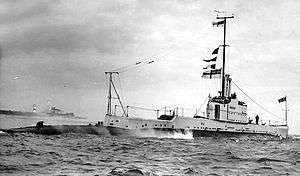HMS Oberon (P21)
  HMS Oberon at sea, bow and stern images | |
| History | |
|---|---|
| Name: | HMS Oberon |
| Laid down: | 22 March 1924 |
| Launched: | 24 September 1926 |
| Commissioned: | 24 August 1927 |
| Decommissioned: | 5 July 1944 |
| Identification: | Pennant number P21 |
| Fate: | Scrapped 1945 |
| General characteristics | |
| Class and type: | Odin-class submarine |
| Displacement: |
|
| Length: | 275 ft (84 m) |
| Beam: | 28 ft (8.5 m) |
| Propulsion: |
|
| Speed: |
|
| Range: | |
| Test depth: | 300 ft (91 m) |
| Complement: | 54 |
| Armament: |
|
HMS Oberon was an Odin-class submarine of the Royal Navy.
Service History
Oberon was the first of the O-Class submarines. She was laid down on 24 September 1926 at the Chatham Dockyard. She was commissioned on 24 August 1927. On 11 October 1935, she collided with the destroyer Thanet at Devonport.[1] Placed in reserve in 1937, Oberon was recommissioned on 2 August 1939 and was used for training during World War II. She was decommissioned at Blyth on 5 July 1944 and was sold for scrap on 24 August 1945.
Notes
- ↑ "HMS Oberon (N 21) of the Royal Navy - British Submarine of the O class - Allied Warships of WWII - uboat.net". uboat.net. Retrieved 2015-05-02.
References
- Akermann, Paul (2002). Encyclopaedia of British Submarines 1901–1955 (reprint of the 1989 ed.). Penzance, Cornwall: Periscope Publishing. ISBN 1-904381-05-7.
- Bagnasco, Erminio (1977). Submarines of World War Two. Annapolis, Maryland: Naval Institute Press. ISBN 0-87021-962-6.
- Chesneau, Roger, ed. (1980). Conway's All the World's Fighting Ships 1922–1946. Greenwich, UK: Conway Maritime Press. ISBN 0-85177-146-7.
- Colledge, J. J.; Warlow, Ben (2006) [1969]. Ships of the Royal Navy: The Complete Record of all Fighting Ships of the Royal Navy (Rev. ed.). London: Chatham Publishing. ISBN 978-1-86176-281-8. OCLC 67375475.
- McCartney, Innes (2006). British Submarines 1939–1945. New Vanguard. 129. Oxford, UK: Osprey. ISBN 1-84603-007-2.
This article is issued from Wikipedia - version of the 5/21/2016. The text is available under the Creative Commons Attribution/Share Alike but additional terms may apply for the media files.